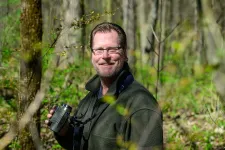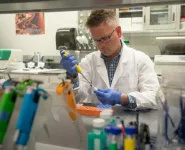Gene-editing therapy aimed at two targets – HIV-1, the virus that causes AIDS, and CCR5, the co-receptor that helps the virus get into cells – can effectively eliminate HIV infection, new research from the Lewis Katz School of Medicine at Temple University and the University of Nebraska Medical Center (UNMC) shows. The study, published online in the journal The Proceedings of the National Academy of Sciences (PNAS), is the first to combine a dual gene-editing strategy with antiretroviral drugs to cure animals of HIV-1.
“The idea to bring together the excision of HIV-1 DNA with inactivation of CCR5 using gene-editing technology builds on observations from reported cures in human HIV patients,” said Kamel Khalili, PhD, Laura H. Carnell Professor and Chair of the Department of Microbiology, Immunology, and Inflammation, Director of the Center for Neurovirology and Gene Editing, and Director of the Comprehensive NeuroAIDS Center at the Lewis Katz School of Medicine. “In the few instances of HIV cures in humans, the patients underwent bone marrow transplantation for leukemia, and the donor cells that were used carried inactivating CCR5 mutations.”
Dr. Khalili and Howard E. Gendelman, MD, Professor and Chair of the Department of Pharmacology and Experiential Neuroscience at UNMC, were senior investigators on the new study. The two researchers have been long-time collaborators and have strategically combined their research strengths to find a cure for HIV.
“We are true partners, and what we achieved here is really spectacular,” Dr. Gendelman said. “Dr. Khalili’s team generated the essential gene-editing constructs, and we then applied those constructs in our LASER-ART mouse model at Nebraska, figuring out when to administer gene-editing therapy and carrying out analyses to maximize HIV-1 excision, CCR5 inactivation, and suppression of viral growth.”
In previous work, Drs. Khalili and Gendelman and their respective teams showed that HIV can be edited out from the genomes of live, humanized HIV-infected mice, leading to a cure in some animals. For that research, Dr. Khalili and co-investigator, Rafal Kaminski, PhD, Assistant Professor at the Center for Neurovirology and Gene Editing at the Katz School of Medicine, combined their expertise in CRISPR gene-editing technology for targeting HIV-1 with a therapeutic strategy known as long-acting slow-effective release (LASER) antiretroviral therapy (ART) that was co-developed by Dr. Gendelman and Benson Edagwa, PhD, Assistant Professor of Pharmacology at UNMC. LASER ART holds HIV replication at low levels for long periods of time, decreasing the frequency of ART administration.
Despite being able to eliminate HIV in LASER-ART mice, the researchers found that HIV could eventually re-emerge from tissue reservoirs and cause rebound infection. This effect is similar to rebound infection in human patients who have been taking ART but suddenly stop or experience a disruption in treatment. HIV integrates its DNA into the genome of host cells, it can lie dormant in tissue reservoirs for long periods of time, out of reach of antiretroviral drugs. As a consequence, when ART is stopped, HIV replication renews, giving rise to AIDS.
To prevent rebound infection, Dr. Khalili and colleagues began work on next-generation CRISPR technology for HIV excision, developing a new, dual system aimed at permanently eliminating HIV from the animal model. “From success stories of human HIV patients who have undergone bone marrow transplantation for leukemia and been cured of HIV, our hypothesis was that the loss of the virus’s receptor, CCR5, is important to permanently eliminating HIV infection,” he explained. They developed a simple and more practical procedure for the inactivation of CCR5 that includes an IV inoculation of the CRISPR gene editing molecule.
Experiments in humanized LASER-ART mice carried out by Dr. Gendelman’s team showed that the constructs developed at Temple, when administered together, resulted in viral suppression, restoration of human T-cells, and elimination of replicating HIV-1 in 58 percent of infected animals. The findings support the idea that CCR5 has a key role in facilitating HIV infection.
The Temple team also anticipates soon testing the dual gene-editing strategy in non-human primates. To do so, Dr. Khalili will collaborate with Tricia H. Burdo, PhD, Professor and Vice Chair in the Department of Microbiology, Immunology, and Inflammation at the Katz School of Medicine, a known expert in the use of non-human primate models for studying HIV-1, who was also a co-author on the new study. Dr. Burdo and her team are interested in understanding the involvement of CCR5 in SIV-infected primates. Her laboratory previously played a key part in research demonstrating the effectiveness and safety of CRISPR-based technology in removing HIV DNA from primate cells.
The new dual CRISPR gene-editing strategy holds exceptional promise for treating HIV in humans. “It is a simple and relatively inexpensive approach,” Dr. Khalili noted. “The type of bone marrow transplant that has brought about cures in humans is reserved for patients who also have leukemia. It requires multiple rounds of radiation and is not applicable in resource-limited regions, where HIV infection tends to be most common.”
“Curing HIV is the big picture,” Dr. Gendelman added. “Through our ongoing collaboration, Temple and UNMC have carried out meaningful research that could ultimately impact the lives of many people.”
In addition to Rafal Kaminski, other researchers contributing to the study include Prasanta K. Dash, Hang Su, Brady Sillman, Chen Zhang, Sruthi Sravanam, Emiko Waight, Lili Guo, Saumi Mathews, R. Lee Mosley, Larisa Y. Poluektova, Santhi Gorantla, and Benson Edagwa, Department of Pharmacology and Experimental Neuroscience, UNMC; and Chen Chen, Pietro Mancuso, Shuren Liao, Hong Liu, Rahsan Sariyer, Maurizio Caocci, and Shohreh Amini, Department of Microbiology, Immunology, and Inflammation, Center for Neurovirology and Gene Editing, Lewis Katz School of Medicine at Temple University.
The research was supported by the National Institutes of Health, including grants T32NS105594, 5R01MH121402, 1R01Al158160, R01DA054535, 1041 R01NS126089, R01 AI145542, R01NS36126, R01MH115860, 1R33DA041018, 1042, and 2R01NS034239 (UNMC), and T32MH079785, P30MH092177, and UM1AI164568 (Lewis Katz School of Medicine).
Editor’s Note:
Kamel Khalili is Co-Founder and Chief Scientific Consultant and holds equity in Excision BioTherapeutics, which has licensed the viral gene-editing technology from Temple University. Kamel Khalili and Rafal Kaminski are named inventors on patents that cover the viral gene-editing technology. Tricia Burdo serves on the Scientific Advisory Board and holds equity in Excision BioTherapeutics. These named researchers are employed by Temple University and conduct research activities sponsored by the company. Questions regarding their affiliations with Temple University may be directed to coisom@temple.edu.
Drs. Howard Gendelman and Benson Edagwa are Co-Founders and Scientific Consultants in Exavir Therapeutics, which has licensed the ultra-long acting prodrug technology from the University of Nebraska Medical Center. Drs. Gendelman and Edagwa are named inventors on patents that cover the LASER ART technology.
Drs. Khalili and Gendelman have not received financial compensation from any other third parties for any aspects of this published work.
In addition to owning the viral gene-editing technology that Excision is licensing, Temple University also holds an equity interest in Excision. As a result of these interests, Temple University could ultimately potentially benefit financially from the outcome of this research. These interests have been reviewed and approved by Temple University in accordance with its Institutional Conflict of Interest policy. Questions about this can be directed to coitemple@temple.edu.
In addition to having an ownership interest in the long-acting antiretroviral technology that Exavir has licensed, UNMC’s technology transfer organization, UNeMed, also holds an equity interest in Exavir. As a result of these interests, UNMC could potentially benefit financially from the outcome of this research.
#######
About the Lewis Katz School of Medicine
Founded in 1901, the Lewis Katz School of Medicine at Temple University attracts students and faculty committed to advancing individual and population health through culturally competent patient care, research, education, and service. The School confers the MD degree; MS and PhD degrees in Biomedical Science; the MA in Urban Bioethics; the MS in Physician Assistant studies; a certificate in Narrative Medicine; a non-degree post-baccalaureate program; several dual degree programs with other Temple University schools; continuing medical education programs; and in partnership with Temple University Hospital, 40 residency and fellowship programs for physicians. The School also manages a robust portfolio of publicly and privately funded transdisciplinary studies aimed at advancing the prevention, diagnosis, and treatment of disease -- with specialized research centers focused on heart disease, cancer, substance use disorder, metabolic disease, and other regional and national health priorities. To learn more about the Lewis Katz School of Medicine, please visit: medicine.temple.edu.
About the University of Nebraska Medical Center
A leading voice on global health security, the University of Nebraska Medical Center (UNMC) and its primary clinical partner, Nebraska Medicine, house one of the nation’s few dedicated biocontainment units and its only federal quarantine unit. While rooted in its mission to serve Nebraska, UNMC also has led the way in such areas as transplantation, infectious disease research, cancer care, advanced simulation and pancreatic cancer research. One of four campuses of the University of Nebraska System, and the state’s only public academic health science center, UNMC serves more than 4,400 students (at five campuses throughout the state) in more than two dozen programs. Along with Nebraska Medicine, UNMC has a $5.9 billion economic impact annually in Nebraska.
END





